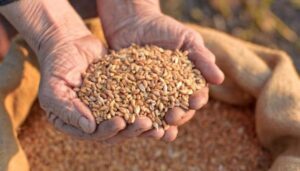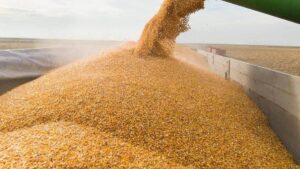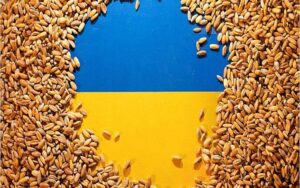
Ukraine has exported 34.862 million tons of grain and leguminous crops since the beginning of the 2023/24 marketing year and as of April 1, of which 5.192 million tons were shipped in March, Deputy Minister of Agrarian Policy and Food of Ukraine for Digital Development, Digital Transformation and Digitalization Denis Bashlyk said in Telegram.
According to the report, in terms of crops, 18.765 million tons of corn, 13.842 million tons of wheat, 1.962 million tons of barley, and 1,000 tons of rye have been exported since the beginning of the current season.
The total export of Ukrainian flour since the beginning of the season as of April 1 is estimated at 79.3 thousand tons, including wheat flour – 75.1 thousand tons.

Polish authorities have agreed with farmers on subsidies per ton of grain and temporary closure of the border with Ukraine from April 1 for the transit of some agricultural products, polskieradio24.pl reported.
According to the newspaper, the document was signed by representatives of the protesting farmers, Agriculture Minister Czeslaw Seckerski and the ministry’s state secretary Michal Kolodziejczak.
The agreement envisages maintaining the current embargo on agricultural products from Ukraine, which has been in place since mid-September last year. It concerns in particular wheat, corn, wheat flour, rapeseed and sunflower.
In addition, the Minister of Agriculture must ask the Council of Ministers of the European Union to suspend the transit of these products through Polish territory as of April 1 this year.
Both sides in the signed document also consider it necessary to develop detailed rules for agri-food trade between Poland and Ukraine, but also note that the difficult situation in agriculture is the result of Russia’s aggression against Ukraine.
Farmers’ representatives in the agreement declare their government’s support for the changes to the Green Agreement. It is primarily about replacing the mandatory transfer to a voluntary ecosystem and simplifying other rules for farmers.
AUTHORITIES, BORDER, FARMERS, GRAIN, POLAND, transit products, UKRAINE

In 2023/24 marketing year, Ukraine exported 31.887 mln tonnes of grains and pulses, down 6.8% compared to the previous year, the press service of the Ministry of Agrarian Policy and Food reported, citing the operational data of the State Customs Service.
According to the press service, 2.217 mln tons of grains and pulses were shipped this month, which is 11.4% more than last year.
According to the report, since the beginning of the current season, Ukraine has exported 12.761 million tons of wheat (989 thousand tons were shipped to foreign markets in March); barley – 1.782 million tons (159 thousand tons); rye – 1 thousand tons (0); corn – 17.059 million tons (1.064 million tons).
Total exports of Ukrainian flour as of March 13 are also lower than last year and are estimated at 75.7 thousand tons (1.7 thousand tons in March), including 71.9 thousand tons of wheat (1.6 thousand tons).

As of the end of February of the 2023/2024 marketing year, which started on July 1, Ukraine has already exported more than 29.1 million tons of grain, legumes and flour, Danylo Hetmantsev, Chairman of the Verkhovna Rada Committee on Finance, Taxation and Customs Policy, said on Telegram.
He clarified that in terms of major crops, 15.8 million tons of corn, 11.5 million tons of wheat, and 1.6 million tons of barley were supplied to foreign markets.
“Compared to the same date last year, there is a lag of almost 2.6 million tons (although, for example, wheat was shipped a quarter of a million tons more than last year),” the head of the parliamentary financial committee said.
Mr. Hetmantsev explained the slowdown in grain exports by the fact that for a month and a half, in July and the first half of August last year, when sea exports were forced to pause due to Russia’s withdrawal from the Istanbul grain initiative, Ukraine had to develop an “alternative grain corridor.” In August 2023, thanks to the Ukrainian Armed Forces, it became available, and in the first months, foreign shipowners were restrained and cautious, looking closely at whether the new route was really safe, he recalled.
“In November 2023, some ‘friends and neighbors’ began to create obstacles for us on the land border under artificial and far-fetched pretexts, and these processes are still ongoing,” Hetmantsev wrote.
The chairman of the parliamentary committee expressed confidence that Ukraine would soon completely close the current gap.
He emphasized that in recent months, Ukraine has returned to almost pre-war export volumes, 90% of Ukrainian grain is shipped to foreign customers by sea, and dependence on the land corridor on the western border is decreasing.
“Thus, Ukraine will continue to play the role of one of the guarantors of global food security, while at the same time replenishing the treasury with serious foreign exchange earnings (in the near future, agricultural products will remain a key item of Ukrainian exports),” Hetmantsev summarized.
The Unity Facility insurance mechanism for grain transportation by Ukrainian sea corridor, announced in mid-November 2023, has been extended to ships carrying not only grain but any other cargoes from February 2024, Oliver Wyman partner Crispin Ellison said.
“By combining the efforts of the industry and the government, we’ve been able to create a mechanism (facility) where prices are well under half of those in the normal commercial market. And now, this month, February, we’ve expanded that facility to include transportation of all cargoes, not just grain,” he said at a Wednesday webinar on political risk insurance organized by the U.S.-Ukraine Business Council (USUBC) and the U.S. Department of Commerce.
He said this will be formally announced on Friday, but the option is already available and effectively triples the mechanism.
Ellison recalled that after Russia withdrew from the Black Sea Grain Initiative, insurance rates increased for the military risk element alone to about 5%, which was completely unaffordable and led to a halt in shipping in July and August.
Established using a public-private partnership (PPP) in which the Ukrainian government provided a $20 million reimbursement fund, the Unity Facility insures approximately 1,000 vessels per year with a maximum insured value of $50 million for each vessel, supporting the export of approximately 30 million tons of grain. The reimbursement fund is accessed through a letter of credit with Ukrainian banks and DZ Bank.
According to Ellison’s submission, a parallel mechanism for cargo coverage, supported by EBRD financing for the Ukrainian government, is being considered.
The expert emphasized that the relatively small amount of insurance capital allowed exporting goods worth about $20 billion, and its estimate is 6-8% of Ukraine’s GDP.
As reported, the Unity Facility was created with the support of the UK government, international reinsurance broker Marsh McLennan and over a dozen more British insurance companies.
According to the Ministry of Restoration, the sea corridor created by the Navy of the AFU and the Danube since August 2023 provided for the export of almost 26 million tons of cargo, of which more than 18 million tons – the products of Ukrainian agrarians. It was specified that from the ports of “Greater Odessa” 854 ships were sent to 42 countries.

Since the beginning of the 2023-2024 marketing year, Ukraine has exported 28.579 million tons of grains and legumes, of which 4.703 million tons were shipped this month, Denys Bashlyk, Deputy Minister of Agrarian Policy and Food for Digital Development, Digital Transformation and Digitalization, said on Telegram, citing data from the State Customs Service.
According to the report, since the beginning of the current season, which began in July 2023, 11.237 million tons of wheat, 1.596 million tons of barley, 15.439 million tons of corn, and 1 thousand tons of rye have been exported.
As of February 26, the total export of Ukrainian flour is estimated at 73 thousand tons, including 69.3 thousand tons of wheat, the Deputy Minister of Agrarian Policy summarized.
As reported, Bashlyk informed that the harvest of grain and legumes in 2023 in Ukraine was carried out on an area of 10.609 million hectares, which is 97% of the plan, from which 58.993 million tons of grain were harvested.
Winter wheat plantings for the 2024 harvest in Ukraine amount to 4166 thou hectares (-834 thou hectares compared to the previous year), winter barley – 536 thou hectares (-255 thou hectares), and rapeseed – 1374 thou hectares (+110 thou hectares).
According to the newly improved forecast of the Ministry of Agrarian Policy, by the end of 2023, farmers can harvest 81.3 mln tons of grains and oilseeds, including 59.7 mln tons of grains and 21.6 mln tons of oilseeds.
Ukrainian agrarians intend to increase the acreage under soybeans and sugar beets and reduce corn, the Ministry of Agrarian Policy reported following a survey of farmers’ preparations for the spring crops sowing campaign for the 2024 harvest.
According to the report, 70% of respondents indicated that they plan to increase the area under soybeans by 21% on average compared to 2023.
The survey of the Ministry of Agrarian Policy, conducted through the State Agrarian Register, showed that during the spring sowing season, Ukrainian farmers will prioritize pulses, which will increase by 11%, and spring barley – by 7%. The area under spring rapeseed is expected to increase by 24%, sugar beet by 17%, and corn by 9%. The area under sunflower may potentially decrease.
In general, in 2024, the area under spring crops may decrease by 0.5 million hectares or 3.7% compared to last season, according to the Ministry of Agrarian Policy.